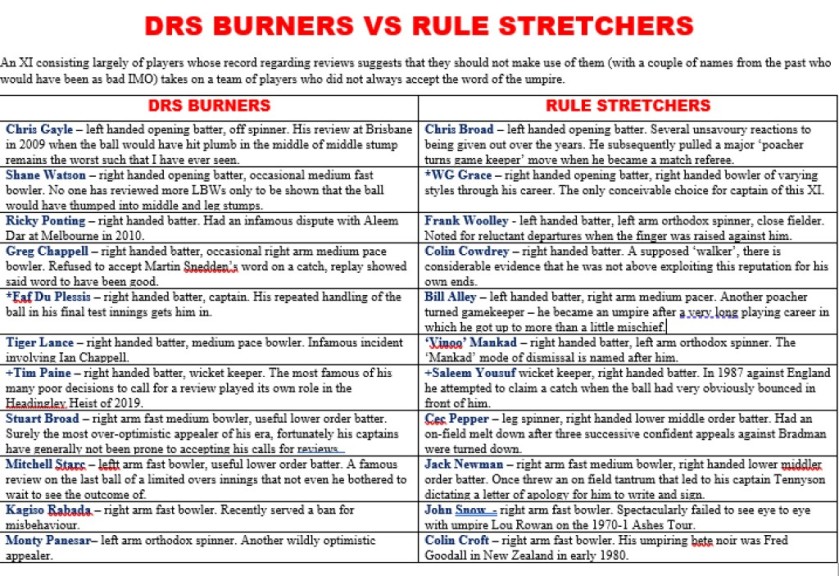INTRODUCTION
Welcome to the latest installment in my ‘all time XI‘ cricket themed series of blog posts. Today’s will require a bit of explaining, but before that there are a couple of matters in connection with yesterday’s post…
A HAT TIP AND A CORRECTION
In yesterday’s image showing the teams in tabulated form I has failed to change their names, so instead of the columns being headed “Playing Cards” and “Alliterative” they read “London” and “The North”, the names of the previous day’s teams. I noticed that this morning when creating today’s tabulated list. Within moments of my teams coming out yesterday Oliver Martens on twitter had come up with the name of Devon born Warwickshire and New Zealand left handed batter Roger Twose (pronounced twos) for the Playing Card XI, an ingenious suggestion. With a career FC average of almost 39 Twose rates above Collis King, and he could be accommodated by splitting the all right opening pair of Hobbs and Robertson, making the Playing Card XI read: Jack Hobbs, Roger Twose, Jack Robertson, Ryan ten Doeschate, Jack Mason, Jack Gregory, John King, Jack Board, Bart King, Jack Walsh and Jack Saunders. Well played, Oliver.
TODAY’S BRIEF
The two teams in action today are called DRS Burners, containing players who would be well advised not to use DRS, strengthened in the middle order by a couple of characters from earlier in the game’s history whose conduct suggests that they may not have been the best users of DRS (middle order batters often don’t get to burn up reviews because the openers have already done so) and the Rule Stretchers, players who have stretched the rules as far as they will go, to say nothing of beyond, and/or have been involved in ructions with officialdom.
THE DRS BURNERS XI
- Chris Gayle – left handed opening batter, occasional off spinner. The worst of his many failed reviews was at Brisbane in 2009 when he sent an LBW upstairs and the replay showed to the surprise of nobody other than possibly Gayle himself that the ball would have hit plumb in the middle of middle stump – as out as it is possible to be.
- Shane Watson – right handed opening batter. In some circles he is referred to as LBWatson because of both the frequency with which he suffered that mode of dismissal and the frequency with which he sent it upstairs only to discover it was stone cold out – usually hitting middle and leg.
- Ricky Ponting – right handed batter. He earned his place in this side at the MCG in 2010 when he had an onfield bust up with Aleem Dar over a decision that most of his team mates were not bothered by, for the very simple reason that Mr Dar had quite clearly got it right. Ponting saw a white mark, nowhere near either bat or ball, on the hot spot replay on the big screen, and his subsequent display of temper, which rivalled that over his run out by Gary Pratt in 2005, cost him 75% of his match fee.
- Greg Chappell – right handed batter, occasional medium pacer (leg spinner earlier in his career), fine slip fielder. He gets in for the first of two incidents involving him in an ODI against New Zealand. He was on 52 when he declined to accept Martin Snedden’s word that he had taken a catch in the deep. It happened that neither umpire had seen the incident, and in the words of one reporter on that match “they gave Chappell the benefit of their ignorance”. The replays showed that Snedden’s word had been pretty good. Chappell went on to reach 90. However this misdemeanour was overshadowed by his subsequent action when Brian McKechnie needed to hit a six of the final ball to force a tie and he instructed his brother Trevor to roll the ball along the ground to prevent that from happening. This provoked a typically hamfisted response from the powers that be, outlawing all underarm bowling. I have explained elsewhere how underarm bowling both of the Simpson-Hayward type and the more vigorous David Harris type could be legalized while running no danger of a repeat of this incident.
- *Faf Du Plessis – right handed batter, captain. He gets in for his repeated handling of the ball during his last test innings. England complained about his behaviour, but as far as I am concerned they should simply have appealed against him and left him to nurse any grievance he felt over being thus dismissed while sat in the pavilion.
- Tiger Lance – right handed batter, right arm medium pacer. This time we have an incident where a member of the Chappell family was the victim. Ian, the eldest brother, hit one which went to Lance, asked that worthy if he had caught it and on receiving an answer in the affirmative headed for the pavilion. A team mate of Lance asked him if was sure about it and Lance replied “he didn’t ask if it had bounced”, earning his place in this side.
- +Tim Paine – wicket keeper, right handed batter. Among the many misjudgements he as fielding captain perpetrated over when to use DRS there was one that assisted England to bring off the ‘Headingley Heist’ of 2019 – he sent an LBW appeal that had been turned down against Stokes upstairs, the ball was quite clearly wide and going on to miss, and a few minutes later he was unable to send another LBW decision upstairs which would have been resolved in his favour had not burned the review.
- Stuart Broad – right arm fast medium bowler. One who does not die wondering. Fortunately his captains have been as well aware of his over optimism in the matter of appeals as the rest of us so he has not actually burned up all that many reviews, but the intent has been there.
- Mitchell Starc – left arm fast bowler. Reviewed an LBW against him at the end of an ODI innings, but realized that it was so absolutely plumb that he did not bother to wait for confirmation.
- Kagiso Rabada – right arm fast bowler. Has recently served a test match suspension for accumulated demerit points.
- Monty Panesar – left arm orthodox spinner. Another who would have burned a stack of reviews given the opportunity but whose captains realized that he was seriously over-optimistic when it came to appealing.
This side has a strong top five, an all rounder, a keeper who can bat and four fine bowlers. Spin options are thin on the ground, but it is a decent side, though it would likely keep the match referee busy!
THE RULE STRETCHERS XI
- Chris Broad – left handed opening batter. Some of his responses to being dismissed were decidedly unsavoury, including a stump demolishing act in Lahore, and various very slow and reluctant departures. He subsequently turned game keeper, becoming a match referee in later years.
- *WG Grace – right handed opening batter, right arm bowler of various styles through his career. The only possible candidate for the captaincy of this particular XI. Stories of him stretching the rules to the absolute limit are legion, one such playing its part in the creation of The Ashes. In Australia’s second innings Sammy Jones left his crease to pat down a divot in the pitch, and Grace whipped the bails off and appealed, and since the ball had not been called dead umpire Bob Thoms raised the finger. This revved ‘the Demon’, FR Spofforth up to a pitch of near homicidal fury, and England needing 85 to win were bowled out for 77 to lose by seven runs. There were many other such incidents in the course of his long career.
- Frank Woolley – left handed batter, left arm orthodox spinner, close fielder. On one occasion he took so long to leave the crease after being given out that the umpire reprimanded him, prompting Woolley to explain “I was not disputing your decision, I just could not believe that such an awful bowler could get me out twice.”
- Colin Cowdrey – right handed batter, slip fielder. He was a self proclaimed ‘walker’, i.e someone who would give himself out without waiting to be told. However, there is a fair amount of evidence that he exploited this reputation to his own benefit, on occasions declining to walk because he knew that his reputation would make umpires reluctant to give him out. There is a big question mark over ‘walking’ anyway, because it was generally ‘amateurs’ who did it, implying that they knew what was going on better than the umpires, who were usually former professionals. If you are going to walk, then you cannot pick and choose your moments, you must do it every time. Personally I would say wait for the umpire’s decison, but once that finger is raised against you do not hang around.
- Bill Alley – left handed batter, right arm medium pacer. After a very long and quite distinguished playing career he became an umpire. There are a couple of stories, or possibly two versions of the same story, from the career of Alley the umpire that suggest he got up to his share of mischief as a player: version 1 features newly minted umpire Alley spotting a youngster tampering with the ball and telling him “no, this is how you do it” and providing a demonstration. Version 2 has Alley seeing the ball near the end of an over and saying to the young bowler “you’ve don a good job on this one, if you don’t get seven-for with it I am reporting you.”
- Vinoo Mankad – right handed batter, left arm orthodox spinner. He was the first bowler in test history to run out a non-striker for backing up too far, a mode of dismissal that now bears his name. My own view is that a non-striker trying to gain an advantage by leaving their ground early and being spotted by the bowler deserves to be run out, and I refuse to sympathise with the batter who is thus dismissed, although I accept that a bowler who deliberate pauses before going into their delivery stride in an effort to lure the non-striker out of their ground is going too far. If anyone on the opposition side is to be ‘Mankaded’ I would want it to be Ponting – his reaction would be something to behold.
- +Saleem Yousuf – wicket keeper, right handed batter. During Pakistan’s 1987 visit to England he claimed a catch when the ball had very obviously bounced well in front of him. The batter who waits for the finger to be raised is merely declining to plead guilty, whereas the fielder (or in this case keeper) who claims that catch in full knowledge that the ball has bounced is more in the position of someone faking evidence for the prosecution.
- Cec Pepper – leg spinner, right handed lower middle order batter. One of the best cricketers to not be picked for his country, the reason he suffered that fate is that he lost his cool with an umpire after that worthy turned down three successive confident LBW shouts by him against Don Bradman. He subsequently moved to England, became a Lancashire League pro and after that a highly respected umpire.
- Jack Newman – right arm fast medium, useful lower middle order bat. He once had an on field blow up which led to his captain, Lionel Tennyson, sitting him down and dictating a letter of apology to be sent to the umpires and the opposing captain. However, having seen to it that Newman produced an appropriate written apology Tennyson then proceeded to give him £5, not a negligible gesture in the 1920s, and one that suggests he recognized that Newman was not entirely at fault.
- John Snow – right arm fast bowler. He famously failed to see eye to eye with umpire Lou Rowan on the 1970-1 tour of Australia. The worst incident, at Sydney, reflects extremely poorly on Rowan. Terry Jenner, no 8 for Australia, but by no means a bunny with the bat, ducked into a short of a length ball and was hit in the face. Rowan after a short pause gave Snow a warning for intimidatory bowling, and the crowd subsequently bombarded the field with bottles and cans. As well as Rowan’s mishandling of the Jenner incident, England were frustrated by the fact that not a single Aussie was given LBW in that series. Also, after a test match at Melbourne was washed out without a ball being bowled, leading to the staging of the first ever ODI, England manager David Clark agreed without consulting skipper Illingworth or the players to the addition of another test match to the schedule, which made that the first and only test series to feature a seventh match (six had been scheduled right from the get go).
- Colin Croft – right arm fast bowler. Right at the start of the 1980s the West Indies suffered what would be their only series loss of the whole decade, in New Zealand, when the hosts sneaked home by one wicket in the only decided match. Colin Croft got so frustrated with the umpiring of Fred Goodall, which does indeed seem to fallen badly short in either competence, impartiality or both that at one stage he barged into him and sent him flying. In that same series Michael Holding kicked the stumps over in response to a poor decision.
This team features a strong top five, a genuine all rounder, a keeper who can bat and four excellent bowlers. The bowling also looks impressive, with Croft, Snow and Newman excellent pace options, Pepper and Mankad to bowl spin, and WG and Bill Alley both quite capable of taking a turn at the bowling crease.
THE CONTEST
This would be a very hard contest for umpires and match referees, but I think that the extra bowling strength of the Rule Stretchers XI would see them victorious. In acknowledgement of a famous incident not commemorated in my selections, and the fact that the two players I thus name definitely did not see eye to eye I will call the trophy for this one the Bradman-Hammond trophy. The incident in question happened in the first test of the 1946-7 Ashes, supposedly a goodwill tour except Bradman did not get the memo. Bradman had reached 28 without showing any great authority when he sent a ball shoulder high to Jack Ikin at second slip. Ikin did not appeal at first purely because he did not think it necessary – it was a high and clear catch. Bradman stood his ground, and when England finally did appeal it was turned down. Cliff Cary, himself an Australian, in “Cricket Controversy”, his account of that tour, makes it abundantly clear that Bradman should have been given out. Hammond’s immediate response was to comment “A fine ****ing way to start a series”. Bradman went on to make 187, Australia to tally 645 and England were then caught on a sticky following a tropical storm. Had Bradman been given out England would have batted before the storm hit, Bradman’s second innings would probably have happened on the sticky, and he might well have called it a day.
A LINK AND PHOTOGRAPHS
Pete Wharmby has produced an excellent twitter thread about autistic students and returning to school after lockdown. Please click on the screenshot below to visit the full thread:
Now it is time for my usual sign off…






























One thought on “All Time XIs – DRS and Umpiring Controversies”